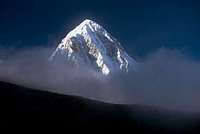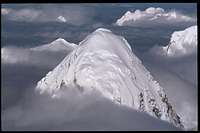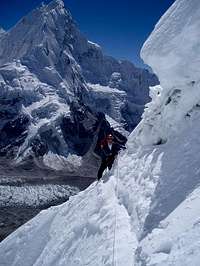-
 61901 Hits
61901 Hits
-
 95.81% Score
95.81% Score
-
 56 Votes
56 Votes
|
|
Mountain/Rock |
|---|---|
|
|
28.01470°N / 86.82810°E |
|
|
Tibet |
|
|
23494 ft / 7161 m |
|
|
Overview
Located in Nepal's Khumbu region as well as occupied Tibet this pyramid shaped 23,495 ft.peak dominates the skyline behind Kala Pataar (19,000 ft). Anyone who has made the trip to Everest either as a climber or trekker will remember Pumori’s distinctive shape. Named by George Leigh Mallory, "Pumori" apparently means "Unmarried Daughter" in the Sherpa language. Used as a training peak for past Everest teams this peak now is offered as a guided climb by many different companies. There may be as many as 20 expeditions per climbing season.
Gerhard Lenser part of a German/Swiss expedition first recorded the summit in 1962.
Getting There
To get to Nepal you will have to fly from either India, Thailand or Singapore.
To get to New Delhi India try (there are many others).
Air India
British Airways
Air France
Air Canada
Kuwait Airlines
Qatar Airways
Lufthansa
KLM
Royal Air Nepal
Once you get to Katmandu you will have basically two options:
1 - Fly on Royal Air Nepal’s Twin Otter flights to Lukla. A small air strip about ten days from Everest Base Camp ( eight from Gokyo peak allowing for acclimitization) 1 hour flight approx.
2 - Take a local bus, Mini Bus hired by you or your Sherpa provider to Jiri. This is a small village at the end of the road. From here it is about a 14-16 day trek to the Gokyo region.
If you have the time do the walk. For three reasons:
1 - You will have a chance to walk through one of the most lush and beautiful lowland areas in Nepal. This is an area that a lot of trekkers miss when flying to Lukla. You will also cross over two high passes with excellent views in all directions.
2 - By taking 2 weeks to arrive in the Khumbu are and having already crossed over two high passes you will be better acclimitized once you arrive in the high peaks area. You will enjoy this more as you will be huffing and puffing less.
3 - You will be following the route taken by most of the early expeditions. There is a lot of history along that path, why not soak it up. You will also have the bragging rights that you did the same route as they in years gone by.
Flying is fast and that has its advantages. But if you have ever been at Lukla after several days of no flights after bad weather you will understand this. (Trekkers fighting over seats to make their connecting flights home)
Red Tape
Yes there are permits required. These can be arrainged by yourself or the firm that you hire to support your team. There is also an entry visa to Nepal.The mountain is not climbed from Tibet.
The below can be of help.
Permits
The General Secretary,
Nepal Mountaineering Association
Post Box No. 1435,
Kathmandu.
Treking info from Eza
Date: Apr 29, 2002 06:30 AM
There used to be no problem when I visited Nepal to get that entry visa. At least for europeans, it could be easily obtained in Tribhuvan International Airport (Kathmandu) by means of producing your passport, a couple of photographs and some twenty five US dollars or so.
When to climb and guiding services
September to November and March to May are the most often used windows. The winter months add the eliment of cold and the monsoon the dangers of snow buildup.
If you are not able to climb as a solo expedition try one of these guided ascents. Most of theses groups guide in the Khumbu.
- Alpine Ascents International
- Adventure Consultants
- Himalaya Expeditions
- Earth Treks
- Jagged Globe submitted by TomBriggs 23/05/02
- Mountain-Link Expeditions
- Mountain Madness
- Mountain Odyssey
- Dan Mazur
The trek in
Flying into Lukla 9,350 ft.:
(Note walking times are approximate a lot will depend on how you acclimitize.)
Slowly decend to Phakding 8,700 ft. about 2 hr walk from Lukla, you will probably overnight here .
The next morning after about 2-3 hours you will pass through Jorsale 9,100 ft. . Here is where you will pay a fee and enter the Sagarmatha (Everest) National Parkand. You will then continue for another 2-3 hours up hill to the main Village of Namche Bazaar 11,300 ft. This is quite an elevation gain especially for those who have flown in. You should rest here one to two days, doing small side trips ect. to acclimitize.
The next day will take you through Shyangboche 11,800 ft. (approx) then onto the village of Khunde 12,600 ft. then onto Khumjung 12,400 ft. then you decend to near the river crossing at 10,650 ft. Cross over at Pungo Tenga. Then it is uphill for two hours to Tengboche. This is another good rest spot.
The following day continue east out of the settlement and down 1.5 hours to Pangboche 12,800 ft. (keep right). Continue for 1.5 hours till you reach a fork in the trail. Go left donw to the river and cross over and uphill to the village of Pheriche (13,950 ft.). Stop here for the night. Here there is a Hospital for treating altitude illnesses.
The next day or so go north along the valley floor to the end and then up to the north-east along the glacial moraine past Dunhla (15,075 ft.) (Climbers memorials) to the Village of Labouche (16,175 ft.) another 2-4 hours will bring you to Gorak Shep. from here you can go to Kala Pattar (18,450 ft.) or Everest Base Camp (17,575 ft.) or if you are going to Pumori you will have to cross the moraine to the left over to it’s basecamp.
Helping the Sherpa community
There are several organizations dedicated to helping the Sherpa community. Here are just two. Should you wish to contribute to this worthwhile cause contact either of the following organizations though the information below.
The Sir Edmond Hillary Foundation
222 Jarvis Street
Toronto, Ontario, Canada
M5B 2B8
(416) 941-3315
The American Himalayan Foundation
The American Himalayan Foundation
909 Montgomery Street, suite 400
San Francisco CA 94133
Telephone (415) 288-7245
Fax (415) 434-3130
Sir Chris Bonington and Doug Scott are also involved in helping the sherpa people
Brief equipment list
Equipment list info:
Here is a brief list for you. Minus the Climbing gear - 6-pairs socks
- 6-underwear
- 2-pairs of shorts for the walk in
- 3-T-shirts for the walk in
- 2-bandanas or a sun hat to keep off the sun
- Sunscreen, sunscreen, sunscreen plus zinc
- Good sturdy hiking shoes
- 1-sleeping bag (as warm as you can get)
- 1-sleeping pad (your choice the more comfortable you are the better you sleep the more energy you will have) you can get a Crazy Creek chair that goes with your pad this is a good investment.
- 2-expedition weight Patagonia long underwear tops (or 1 depends on how dirty you like to be)
- 1-expedition weight Patagonia long underwear bottom
- 1 lightweight fleece bottom
- 1-heavy weight Patagonia or similar fleece jacket
- 1-Gortex shell jacket
- 1-Gortex shell pants (full length zippers)
- 1-Down filled jacket liner from Feathered Friends of Seattle, (optional but I always end up using it)
- 1-Downfilled Gortex guides Parka 1-Warm hat with ear flaps
- 2-pairs of heavy duty mittens (in case you lose one pair up high)
- 1-pair fleece gloves 1-pair ski gloves
- 1-pair of Koflach double plastic boots, One Sport (warmer)($$$) or Asolo (I prefer Koflach, I find them more comfortable)
- 1-pair of gaitors
- 1-pair ski poles
- 1-ice axe
- 1-pair of sharp crampons (test them on your boots before you leave and make sure they fit perfectly)
- 1-headlamp with extra batteries and bulbs
- 1-cup with spoon attached
- 1-Swiss army knife
- 1- stove of your choice (I use Markhill stormy hanging stone with Blueway cartridges, you will have to get fuel in Nepal as it is difficult to fly over) Allow at least 1 canister per day for up high per 2-man tent.
- 1-4 tents one set up at base camp. one at camp 1, and another 2 for higher up.
3-1-litre water bottles with insulators (drink at LEAST 5 litres a day to help acclimatize)
Food....
Political situation
Note on Nepal
There had been a cease fire and talks between the Government and the Maoist who were causing issues in parts of the country. This has led to them being included in the government. Lets hope this coalition holds so that locals, trekkers and climbers can all enjoy this wonderful place in peace.
External Links
- www.adesnivel.pt/pumori
Portuguese Mountaineering Association
- www.adesnivel.pt/pumori









